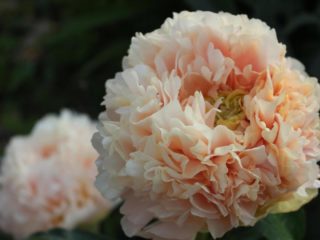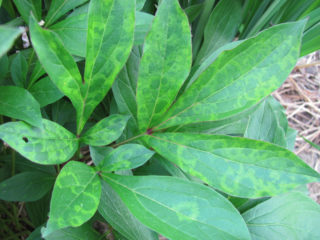Content
Peony Charles White is a herbaceous variety of perennial flowering plant, bred by breeders in 1951. Everything about it is beautiful - a delicate aroma, a beautiful bush, luxurious flowers. The variety has many advantages: unpretentious, winter-hardy, and not susceptible to diseases and pests. A huge advantage of the “Charles White” peony is its durability; the lifespan of the bushes is calculated in decades.

The peony core may have a yellowish tint
Description of peony Charlies White
"Charles White" is a classic variety of ivory-colored peonies with large decorative leaves. Very tall, grows quickly, suitable for planting at the back of the front garden. The peduncle has a height of up to 90 cm. The bush is spreading, large in size, and needs a special support that will support heavy flower caps, especially in unfavorable weather. To plant a peony, it is preferable to choose a place in a sunny area, since the culture is light-loving. The bush can tolerate partial shade for no more than 3-4 hours a day.
The variety has high frost resistance and can withstand temperatures down to -26 °C. Suitable for growing in climatic zone IV.It takes root well in the regions of Northern Siberia, the Kamchatka region, Yakutia, Primorsky Territory, the Far East, the Moscow region, Bashkortostan, Karelia and St. Petersburg.
Features of flowering
The peony variety Charlie s White belongs to the milk-flowering group of plants. The formation of buds begins at the end of May - the first half of June. The flowering period is considered early, and its duration and abundance completely depend on the growing conditions. If the peony grows in a bright and spacious area, it is cared for in a timely manner and the necessary fertilizing is applied, then the bush will delight with fragrant inflorescences for 2-3 weeks. To ensure the plant blooms abundantly, you need to immediately remove the central flowers after wilting. Then the new buds will have the opportunity to grow to their full potential.
Peony flowers have a graceful shape. The buds are spherical, double, with large white petals on the outer row and curling, short petals on the inner row. Each flower reaches 17 cm in diameter and has a light aroma. Perfect for creating bouquets and flower arrangements.

Cut snow-white peonies make very delicate bouquets
Application in design
In total, at least 5 thousand varieties of peonies have been registered in the world, but not all are suitable for use in the landscape. As for the “Charles White” species, it looks great in flower beds, flower beds and front gardens, not only during the flowering period, but also at the time of fruiting. To demonstrate all the splendor of the variety, it is planted in the most visible place.
Since the plant needs space, the best background for it can be emerald lawn grass. Peony is also good in circular planting and decorative compositions, but in this case it is better to shade it with dark-colored plants. “Charles White” looks beautiful against the backdrop of silver spruce, irises, crown lychnis; not far from the peonies you can plant tall shrubs, trees and low-growing flowering plants.
Thanks to the beauty and large size of the flower, the Charles White peony is perfect for mixborders. Between its bushes, bulbous flowers will look harmonious: tulips, lilies.
The variety is incompatible with adonis, hellebore, lumbago, anemone and flowers of the ranunculaceae family. The roots of these plants secrete substances that inhibit peonies. Also, “Charles White” is not usually planted on loggias or in flowerpots, since it needs a lot of space for a comfortable life.

The bushes are durable, unpretentious and attractive in appearance.
Reproduction methods
Decorative peony "Charles White" is propagated by seed, using cuttings, and also by bush division.
Reproduction methods:
- The fastest and easiest option is to divide the roots of the plant. For this purpose, preference is given to mature bushes that are 3 years old or more. They are dug up, divided into several parts and planted. After this, in order to get a beautifully blooming peony, you need to take proper care of it.
- When propagating by cuttings, gardeners have to wait a long time for the plant to bloom, about 5 years.
- Charles White seeds are usually propagated by plant breeders as it is a labor-intensive and time-consuming process.

If a peony is replanted in the fall, it will take root better in a new place
Landing rules
Autumn or mid-spring is considered a favorable period for planting the Charles White peony variety. In this case, the flower will easily be accepted in a new place and will be less susceptible to disease. The ideal site for the plant would be an open area well lit by sunlight. It should be prepared several days before planting. To do this, you need to dig a shallow hole and fill most of it with a mixture of sand, humus and peat. You can also add iron sulfate (20 g), 200 g of superphosphate, 500 ml of ash.
When planting an adult peony bush, you must adhere to the following rules:
- Carefully dig up the plant.
- Rinse the root system with water.
- Keep the peony in the shade for several hours.
- Trim the stems 10 cm from the root.
- Use a sharp knife to separate the Charles White rhizome into pieces.
- Remove rotten or damaged shoots.
- Briefly place the “cuts” in a solution of potassium permanganate, dry, and sprinkle the sections with charcoal.
- Plant the bushes in the planting hole so that the buds are located 5 cm above the top layer of soil, and the distance between each seedling is at least 0.7 m.
- Cover the plant with soil, mulch with peat, and water generously.

Leaves and stems need to be trimmed before planting.
Aftercare
The herbaceous peony "Charles White" is considered a "homebody" plant and does not need frequent replanting. With proper and timely care, its varietal qualities should appear the very next year after planting and last for at least 8 years.
The plant needs frequent watering, but the moisture should not stagnate in the soil for a long time. Periodically, the soil around the bush needs to be loosened; it is unacceptable for the soil to be compacted. If fertilizers were present in the substrate when planting the peony, then it does not need fertilizing for the first 2-3 years. Next, at the time of flowering, the Charles White bushes are fed with phosphorus-potassium preparations, wood ash or a complex of fertilizers:
- 10 liters of water;
- 20 g each of potassium sulfate, superphosphate and ammonium nitrate;
- 1 liter of horse manure.
Highly acidic soil must be limed.
Rotted horse manure is best suited for mulching peonies. Straw or foliage as mulch can become a source of plant infection with fungal diseases.

To prevent the stems from breaking, you need to install a support
Preparing for winter
With the onset of frost, in mid-autumn, the stems of "Charles White" need to be trimmed, leaving stumps above the buds no more than 2 cm high. After pruning, it is advisable to feed the plant with organic or phosphorus-potassium fertilizers.
For the winter, peonies need shelter; immature compost, sawdust, spruce or pine spruce branches and peat can serve as materials for this.

It is best to mulch the plant with peat or sawdust.
Pests and diseases
If we compare peonies with other garden flowers, we can say that they are well resistant to various diseases and insect attacks.Among pests, they have few enemies, which cannot be said about diseases, which are important to recognize and eliminate in time.
Peonies are often susceptible to attack by viruses and fungi:
- rust;
- spotting;
- powdery mildew;
- lemoine;
- cucumber mosaic;
- gray rot;
- tobacco virus.
White varieties of the plant, such as "Charles White", usually suffer from several diseases at once and are difficult to treat.

In case of diseases, damaged leaves must be immediately removed and burned.
Of the parasites that can attack these plants, the best known are:
- root-knot nematode;
- bronze beetle;
- thrips;
- turf ant.
When any pest is detected, it is necessary to immediately apply methods to combat them.
Conclusion
The Charles White peony is a royal flower found in many home gardens. Flower growers fell in love with it for its lush snow-white buds and delicate aroma. The variety is characterized by external splendor and the ability to combine with other flowering plants. Does not require special care and thrives in almost all types of soil. In addition to decoration in the garden, peony is used in medicine to treat women's diseases, liver, tuberculosis and bronchitis.
Reviews of peony Charles White








